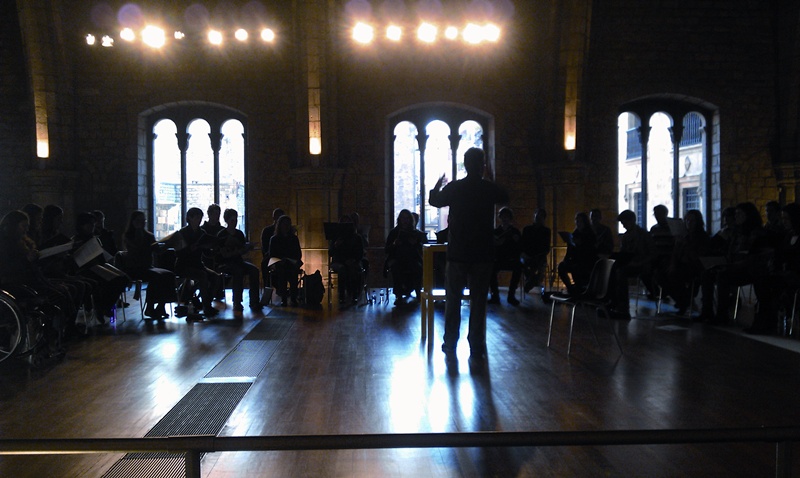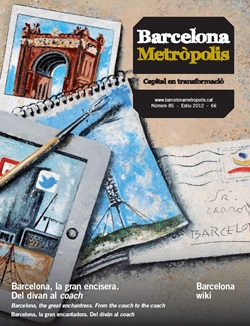Fònics 2.0 describes itself as a dynamic music group that selects its performers through the internet. Its first project was to stage Britten’s A Ceremony of Carols, a concert that was held on 20 February last year at the Palau Falguera in Sant Feliu de Llobregat, with a choir of 18 young women selected in auditions publicised on the internet. The initiative was developed by the current director of Fònics 2.0, Lluís Vilamajó, who works with his other team members, Alba Carbó, Mireia Font and Laia Santanach.

© Fònics 2.0The Saló del Tinell was the rehearsal venue for a project focusing on music from the Spanish Renaissance and Italian Baroque, organised by Fònics. The concert took place on 11 February at Pedralbes Monastery.
The platform secures the resources it needs for its projects through exchanges. Neither Fònics 2.0, nor the members of the organisation, nor the participating musicians get any financial gain from the activities. For example, for one project relating to the Spanish Renaissance and Italian Baroque, an agreement was reached with the Museu d’Història de Barcelona (Museum of History of Barcelona, or MUHBA) by which Fònics 2.0 would offer a concert in the museum if MUHBA provided a rehearsal space for the programme.
Santanach explains what prompted them to start up an initiative that has no equivalent anywhere else. “We wanted to make music in a group, but not just any old way. We wanted to work with people who were 100% involved, who would come to rehearsals with an in-depth knowledge of the repertoire and want to really engage with the group performance work. It is very difficult to create a group of musicians with this level of commitment; that’s why we looked at different ways of achieving it. We decided to go for projects that use the internet to put out the call for musicians. The internet notification lets everyone know what is expected of them, what the repertoire is and the dates, so everyone can decide whether or not to take part. At the auditions, the director can see if the musicians have taken the commitment seriously and can observe their attitudes and aptitudes.”
The cost of a wiki-based initiative does not tend to be very high, but it does require considerable drive and many hours. Santanach recalls how, once they had decided on the idea, the real work began of turning it into a reality. “It’s normally a case of ‘he who pays the piper calls the tune’. If you want free rein over the what, where, when and how, you are either wealthy and you pay for it yourself or you decide that no-one pays, which is what we’ve done. We work on a quid pro quo basis and that gives us a lot of freedom.” For Santanach, the most exciting project to date was the Britten one, because it was the first and they had no idea what response to expect. They got the pianist Josep Surinyac onboard and “more people signed up for the auditions than we expected; people of very high quality,” he says. “Everyone got very involved in the process and the atmosphere was amazing. The musicians that took part valued the experience very highly and the concert was highly acclaimed by audiences.”
This success was repeated with a project based on music of the Spanish Renaissance and Italian Baroque last February. “For me, it was a big step forward in two ways. Firstly, because of the collaboration and level of understanding with the people at MUHBA, who let us rehearse and give a concert in some of the city’s most incredible spaces, like the medieval Saló del Tinell, the Picasso Museum and the Monastery of Pedralbes. Secondly, because of the huge number of people involved: from the 90 people who signed up for the auditions to cover 27 places, to all the private individuals who have offered spaces in which to carry out the projects, and the big audiences that have come to see us.”
As with any project based on cooperation, there are many ways of getting involved. Santanach mentions that some people “loaned their dining rooms for small-group rehearsals”. Others have helped with historical research, with photographs and with publicity. The performer explains that these exchanges and working with the people involved in the different projects have taught her a great deal about many different subjects.
The fact that Fònics 2.0 is an internet-based project is one of the key factors in its success: “Information technology allows a small group like ours to organise projects, coordinate them, put out a call for people, promote exchanges and develop word-of-mouth communication very quickly. Otherwise, we would have to invest much more time and energy in each project and it would take us a lot longer to get Fònics known by potential participants.” We look forward to the next production.



